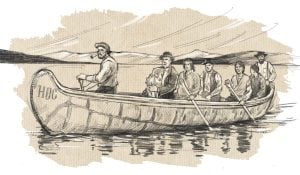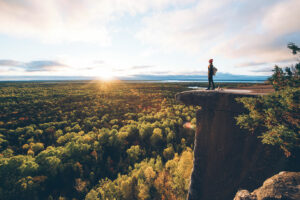
History
L’histoire inédite de la Compagnie de la Baie d’Hudson
Une rétrospective des débuts de l’institution fondée il y a 350 ans, qui revendiquait autrefois une part importante du globe
- 5168 words
- 21 minutes
Travel
Tadoussac is a centre for visitors eager to whale watch, snorkel and learn more about the unique ecosystem of the Saguenay-St. Lawrence Marine Park

It was like watching synchronized swimmers at the Olympics — two enormous humpbacks emerged from the St. Lawrence River, breaching in perfect tandem. It seemed as if they knew they had an audience and understood what we were waiting to see.
“Double breach!” yelled Catherine Dubé, our guide from Croisières AML, the cruise-excursion company operating the whale-watching trip. The moment was magnificent, spectacular, surreal. Coming in the fall of 2020, it reminded me of a French phrase — la vie est faite de petits bonheurs — life is made of small pleasures.
On the north shore of the St. Lawrence River where it meets the Saguenay River, this area has always been important to Innu, Wolastokuk and Mi’kmaq Peoples. The village of Tadoussac was established as a trading post by the French in 1599 and quickly became an important centre for the fur trade. Today, the village is located at the heart of the Saguenay-St. Lawrence Marine Park, created in 1998 by the governments of Quebec and Canada to protect the area’s special ecosystem.
Spanning some 1,245 square kilometres — two-and-a-half times the size of the island of Montreal — the park is home to more than 1,800 animal and plant species. It also happens to be one of the best places in the world for whale-watching in general and one of the few places in the world to spot both beluga and blue whales.
The park’s oceanographic features make it an ideal feeding ground for diverse species — from whales to porpoises, seals to myriad sea birds. Here, cold salt water flowing upstream from the Atlantic reaches Tadoussac, forcing the deep water (cold and rich in decom- posed organic matter) up toward the surface, where it mixes with freshwater. This phenomenon, called an upwelling, brings nutrients and zoo-plankton (krill) to the surface.
Since 2018, watercraft navigation has been prohibited in Baie Sainte- Marguerite (30 kilometres upriver from the mouth of the Saguenay at Tadoussac) during the summer, a measure intended to reduce noise, disturbance and the risk of collisions with the area’s endangered beluga whales. The Parks Canada team monitors the belugas and marine traffic through a project that’s part of its conservation and restoration efforts aimed at “sharing the waters with belugas.”
With Canadians staying close to home, tour operators are hoping whale-watching will make a splash this summer.

1 P.M.
A three-hour drive from Quebec City plants me in the Côte-Nord region along the St. Lawrence River on Route 138 (referred to in the region’s tourism literature as Route des Baleines — whale route). I stop to stretch my legs and take in the grand views and still waters — it’s September and the lush greens are woven into the beginnings of vibrant fall colours. Our car pulls onto the Tadoussac-Baie-Sainte-Catherine Ferry at the entrance of the Saguenay Fjord, a free service that runs year-round.
3P.M.
We arrive at our first destination, the Cap-de-Bon-Désir Interpretation and Observation Centre — part of the Saguenay-St. Lawrence Marine Park and a natural platform used to observe whales, seals and seabirds from the shore. We meet the Parks Canada team who lead us down to the rocky shore for a special presentation. A passionate guide, Marilou Sirois, director of educational operations for Explos-Nature, provides an in-depth and up-close introduction to several local sea creatures. Sea urchins, spiny sunstars and blood stars, among other aquatic creatures, are plucked from the cold waters and placed in a pool with chunks of ice so the temporary enclosure feels like home.
5P.M.
Less than eight kilometres from the park, I arrive at Parks Canada’s Marine Environment Discovery Centre in Les Escoumins. I take a seat in the theatre to watch a fascinating video featuring experienced divers who introduce us to a vibrant underwater world that includes green sea urchins, sea cucumbers and sea stars. Outside, panoramic views offer the chance to observe whales and seals, which often swim near the shore. For the brave, Nor- dic snorkelling in the St. Lawrence is a once-in-a-lifetime experience. I head to the diving base to meet diver Joanna Blanchard, who has just returned from an outing. “So, how cold is it?” I ask. “It’s not as cold closer to the surface,” she says with a grin as she helps me into a thermal wetsuit. It feels like I am being stuffed into a sausage casing. Sure, 4 C sounds cold, but once I am lowered into the water and my face is submerged into the clear water (this activity is recommended at low tide for better visibility), I forget about the temperature as I am drawn to an underwater garden filled with sea urchins, tiny fish, blue mussels and starfish as big as my head.
8P.M.
First erected in 1864 — with the current hotel rebuilt in 1942 by William Hugh Coverdale, who was president of Canada Steamship Lines at the time — Hôtel Tadoussac is an iconic landmark. It’s also a cosy spot to dine on regional cuisine after a day of sea life adventures. The walls of Le Coverdale restaurant feature murals that highlight the rich history of the area.

9 A.M.
I head down to the wharf for my whale-watching excursion (tours run from May to October) with Croisières AML. The Zodiac pulls slowly away from the bay. Strict speed limits and other regulations within the marine park help protect the whales. The Zodiac must maintain at least a 200-metre distance from the whales or 400 metres in the case of endangered and threat- ened marine mammals such as belugas and blue whales. Whales always have right-of-way. I spot several pods of belugas (the only whale that lives here year-round) and a minke whale (the smallest of the baleen whales) swimming alongside a mom and baby fin whale (the second largest and one of the fastest whales).
The highlight of the day is a lesson in looking with your eyes and not through a lens. Humpbacks are known to show their tails when they dive and have a dive time anywhere from eight to 15 minutes. Occasionally, they stay below the surface for up to 30 minutes. I wait patiently to see if one will greet us. Then, right on cue, out of the mighty waters they rise — not one, but two gentle giants — moving freely through the air before plunging back into the St. Lawrence. Researchers can identify each whale by their pectoral fins and the telltale black and white patterns on the undersides of their tails. The most famous and regular visitor to the St. Lawrence is known as Tic Tac Toe. She was given the name because she has an “X” on the right fluke of her tail.
4P.M.
After a hot shower and a quick jaunt to the village shops, I walk to the Marine Mammal Interpretation Centre, which houses an interactive exhibit on whales and related scientific research. I then head outside for a leisurely hike along the Pointe-de-l’Islet trail with its picturesque views of the St. Lawrence River and the Saguenay Fjord (it’s also a great spot for whale-watching).
6P.M.
In the heart of the Saguenay- St. Lawrence Marine Park, I dine at La Galouïne Auberge and Restaurant. Anishinabeg executive chef Martin Brisson serves up homemade smoked salmon and duck breast complemented with artisanal Terroir Boréal products such as wild berry confits and spreads, as well as spices and Labrador tea flavoured with berries from the boreal forest. I order the Galouïne tapas basket — finger foods that include smoked haddock, regular and maple-smoked salmon, marinated turbot, cold-water prawns, homemade confits, cedar jelly and lobster salad. My main is a rich and cheesy seafood casserole filled with salmon, scallops, white fish, shrimp and pollock.

6:30 A.M.
I pull back the curtains in my room at the Hôtel Tadoussac to see the sun kissing the calm morning waters. I head down to Le Coverdale for a quick breakfast before saying goodbye to this small yet mighty village. As I head toward the ferry dock to make my way back to Quebec City, I notice the trees have gotten more colourful in just the last few days and I smile. I feel rejuvenated for the season ahead.
Are you passionate about Canadian geography?
You can support Canadian Geographic in 3 ways:

History
Une rétrospective des débuts de l’institution fondée il y a 350 ans, qui revendiquait autrefois une part importante du globe

Travel
Un nouveau mouvement créateur de pôles touristiques florissants dans tout le Canada – la durabilité, un exemple à la fois

People & Culture
Les journalistes autochtones créent des espaces pour enquêter sur les crimes commis dans les pensionnats pour Autochtones, aux prises avec des questions non résolues et une reconnaissance pour laquelle il reste beaucoup de chemin à parcourir.

Wildlife
En comprenant pourquoi les animaux se comportent comme ils le font, nous pouvons mieux les protéger tout en sensibilisant les gens à leur statut précaire